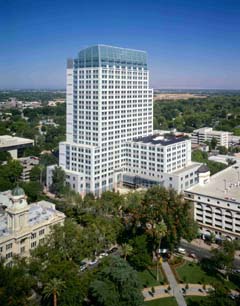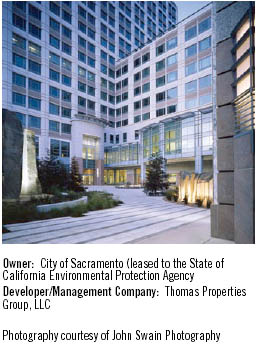Project Background
The California Environmental Protection Agency has a mandate to conserve fiscal resources and a mission to protect the environment. LEED® allows them to do both: the Joe Serna Jr. California Environmental Protection Agency Headquarters Building (Cal/EPA) incorporates the latest green design and engineering principles to be both sustainable and economically competitive.

Cal/EPA, in downtown Sacramento, is the city’s largest high-rise real estate project. The 25-story, 950,000-square-foot office building was built in 2000 by developer Thomas Properties Group, LLC in a public-private partnership with the City of Sacramento.
From Green to Platinum
After Cal/EPA opened, Thomas Properties Group sought a valid, comprehensive way to recognize and verify the building’s ongoing sustainable performance. With some refinements and expansions to its as-designed features, Cal/EPA became the first LEED for Existing Buildings Platinum certified building in 2004.
Thomas Properties invested $500,000 in efficiency upgrades to equipment, operations and employee practices. These improvements generated $610,000 in annual savings, paying for themselves in less than one year. Using an 8% capitalization rate, the annual cost savings have increased the asset value of the building by nearly $12 million.
Strategies and Results
Increased water and energy efficiency and reductions in waste disposal costs have significantly lowered operational costs at Cal/EPA. Native, drought-resistant grasses, plants, and trees minimize storm water runoff and reduce heat build up. The building also features low-flow toilets, water-free urinals, and water-efficient fixtures. These measures have decreased exterior water use by 50 % and interior water use by 20%.

Energy saving measures include highly efficient HVAC and lighting systems, photovoltaic rooftop panels, and a plate and frame heat exchanger that reduces on/off cycling of the chiller equipment, extends equipment life, and saves energy. The Cal/EPA building is 34% more efficient than California’s 1998 energy code and earned an ENERGY STAR® rating of 96 (out of 100) from the U.S. Environmental Protection Agency in 2002. Additional energy use is offset through the purchase of Green-certified power.
Unconventional strategies have led to significant operational savings. Craig Sheehy, Director of Property Management for Thomas Properties, initiated a vermicomposting program which diverts over 10 tons of waste from landfills and saves $10,000 annually. Other non-traditional improvements include eliminating garbage can liners and using reusable cloth bags in centrally located recycling bins, which together save $80,000 per year.

Cal/EPA also demonstrates environmental leadership via employee incentives and a facility layout that encourages walking, biking, carpooling, and driving alternative-fueled vehicles. Materials are chosen based on recycled content, durability, and adjustability to space changes, and salvaged materials are used whenever possible. The waste reduction program—which boasts a 56% occupant recycling rate—keeps more than 200 tons of garbage out of landfills every year.
A Productive Workplace
A healthy indoor environment is paramount to having productive employees while reducing absenteeism and improving employee retention. Cal/EPA boasts an indoor environment free of smoke and chemicals with state-of-the-art ventilation and lighting systems that maintain optimal temperature and illumination levels. More than 80% of office space is filled with natural light, while wooded pathways provide employees with refreshing places to walk and eat lunch.
About LEED®
The LEED® Green Building Rating System™ is the national benchmark for the design, construction, and operations of high-performance green buildings. Visit the U.S. Green Building Council’s Web site at www.usgbc.org to learn more about how you can make LEED work for you.